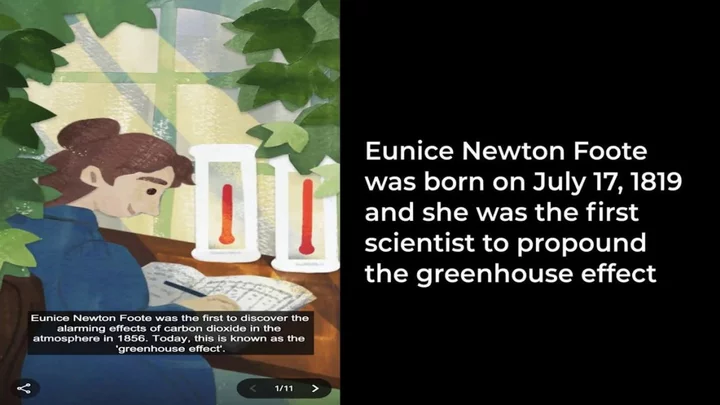
Who is Eunice Newton Foote? The scientist celebrated in today's Google Doodle
We talk about climate change and the devastating effects of greenhouse gases on a daily basis, yet many of us have never heard of Eunice Newton Foote. The American scientist was the first person to realise the alarming impact of carbon dioxide in the atmosphere, all the way back in 1856. So, to mark what would have been her 204th birthday, Google has dedicated today’s Doodle to the environmental pioneer. Head to the search engine and you’ll find an 11-part slideshow explaining Foote’s most significant work. Sign up for our free Indy100 weekly newsletter It goes on to point out that her research was largely ignored for almost 100 years, and credits her with being the first person to “plant a seed of interest in the issue of climate change”. And for anyone wondering, her surname is no coincidence: her father was allegedly a distant relative of Sir Isaac Newton. In a blurb to its Doodle, Google points out that whilst science was Foote’s lifelong passion, she also dedicated time to campaigning for women’s rights. In 1848, she attended the first Woman’s Rights Convention in Seneca Falls, New York State and became the fifth signatory of the Declaration of Sentiments — which demanded equality for women in social and legal status. Back then, women were largely shunned from the scientific community, but this didn’t stop Foote from conducting experiments on her own. After placing mercury thermometers in glass cylinders, she noticed that the cylinder containing carbon dioxide heated up the most and took the longest to cool down. As a result, she became the first scientist to draw a connection between rising CO2 levels and the warming of the atmosphere. After publishing her findings, Foote wrote a second paper on atmospheric static electricity for the journal ‘Proceedings of the American Association for the Advancement of Science’. These were the first two physics studies to be published by a woman in the US, as Google notes. In 1856, a male scientist presented her work at the annual meeting of the American Association for the Advancement of Science. This then lead to further experiments which uncovered what is now known as the Greenhouse effect. And whilst none of us relish the fact this phenomenon exists, we should be eternally grateful to Foote for flagging it to us, all those years ago. Have your say in our news democracy. Click the upvote icon at the top of the page to help raise this article through the indy100 rankings.
2023-07-17 15:46

Christopher Nolan's daughter is a nameless burns victim in Oppenheimer
Christopher Nolan's eldest child, daughter Flora, makes a cameo in the forthcoming flick.
2023-07-17 15:28

Shut Up and Dance hitmakers Walk the Moon announce hiatus
Walk the Moon are embarking on a hiatus and give emotional message with fans as group unsure on future.
2023-07-17 15:24

What to stream this week: Steph Curry doc, Greta Van Fleet, 'Justified' returns and 'Minx' survives
This week’s new entertainment releases include a documentary on Apple TV+ that chronicles the atypical path Stephen Curry took to becoming a basketball legend, new tunes from the rock band Greta Van Fleet and a “Justified” limited series starring Timothy Olyphant
2023-07-17 12:16

Eminem performs 'Lose Yourself' during surprise appearance at Ed Sheeran's Detroit concert
The audience at Ed Sheeran's concert in Detroit on Saturday lost themselves in the music when Eminem showed up for a surprise hometown performance.
2023-07-17 03:23

Actress and singer Jane Birkin dies, France loses an 'icon'
By John Irish PARIS (Reuters) -British-born actress and singer Jane Birkin, a 1960s wildchild who became a beloved figure in
2023-07-17 01:57

‘Mission: Impossible’ debuts with $80M over five days, igniting box office but missing expectations
After a globe-trotting publicity blitz by star Tom Cruise, “Mission: Impossible – Dead Reckoning Part One” launched with a franchise-best $80 million over five days, though it came in shy of industry expectations with a $56.2 million haul over the three-day weekend
2023-07-17 00:58

Arizona senator leans on astronaut past to call for climate crisis action amid blistering heat wave
Democratic Sen. Mark Kelly on Sunday leaned into his experience as an astronaut to call for climate crisis action amid a blistering heatwave across the United States, including his home state of Arizona.
2023-07-17 00:51

Washington legal pot farms get back to work after pesticide concerns halted operations
Some legal cannabis growers in Washington state who were ordered to halt operations in April over concerns about pesticide contamination are getting back to business
2023-07-16 23:20

Microsoft signs agreement to keep Call of Duty on Playstation
Microsoft has signed an agreement to keep Call of Duty on PlayStation following the acquisition of Activision Blizzard,
2023-07-16 22:58

Why college is getting more expensive
The average American saved $5,011 last year. That means it would take them about 75 years to save up enough cash to send one child to a top-rated US university.
2023-07-16 22:47

How one lake has captured the moment we changed the world forever
The floor of Crawford Lake in Ontario acts like a storybook, preserving Earth’s recent history in chronological order. Crawford Lake reveals the activities of local Iroquoian communities from the late 13th to 15th centuries, all the way through to the present day. This is because Crawford Lake is a meromictic lake, meaning that the dense bottom layer of water does not mix with the less dense upper layers. “The isolated bottom layer of water remains under disturbed, enabling the accumulation of clearly laminated valves which record precise information about the time during which they were deposited,” according to the Anthropocene Working Group. Experts have nominated Crawford Lake as representation for the start of the Anthropocene epoch, a proposed new geological era characterised by significant changes to the planet’s surface as a result of human behaviour. The Anthropocene is yet to be officially accepted as a unit of geologic time, but in 2016 a working group under the guidance of an International Commission on Stratigraphy subcommittee agreed that human behaviour has left scars so deep that they will remain evident even into the distant future. Sign up to our free Indy100 weekly newsletter One of the most notable markers of the Anthropocene is the appearance of plutonium, a radioactive material that appeared in the mid-20th century as a result of hydrogen bomb tests. “The presence of plutonium gives us a stark indicator of when humanity became such a dominant force that it could leave a unique global ‘fingerprint’ on our planet,” explained Professor Andrew Cundy, Chair in Environmental Radiochemistry at the University of Southampton and member of the Anthropocene Working Group. “In nature, plutonium is only present in trace amounts. But in the early-1950s, when the first hydrogen bomb tests took place, we see an unprecedented increase and then spike in the levels of plutonium in core samples from around the world. We then see a decline in plutonium from the mid-1960s onwards when the Nuclear Test-Ban Treaty came into effect.” Agreeing on a simple measure that defines the boundary between chapters in Earth’s history is just the first step. This measure requires agreement among scientists on a single location to define the boundaries. Known as the Global Boundary Stratotype Section and Point, or a golden spike, plays a crucial role in standardising these borders between epochs. The Anthropocene Working Group has been evaluating potential golden spike sites, from Oued Akrech, Morocco, to Alano di Piave, Italy. After spending three years assessing the qualities of a dozen potential golden spikes for the Anthropocene, finally the AGW has landed on Crawford Lake. “Crawford Lake is so special because it allows us to see at annual resolution the changes in Earth history throughout two separate periods of human impact on this small lake,” micropalaeontologist Francine McCarthy of Brock University in Canada, a voting member of the AGW, said at a press briefing. The lake’s unique properties, such as its small size, depth, and lack of water mixing create sediments that precisely record environmental changes over the past millennia. To officially establish the Anthropocene in the International Chronostratigraphic Chart, the golden spike at Crawford Lake must undergo a series of voting by various commissions and unions. If successful, it will mark the moment when human activities permanently altered the planet. Have your say in our news democracy. Click the upvote icon at the top of the page to help raise this article through the indy100 rankings.
2023-07-16 17:29
